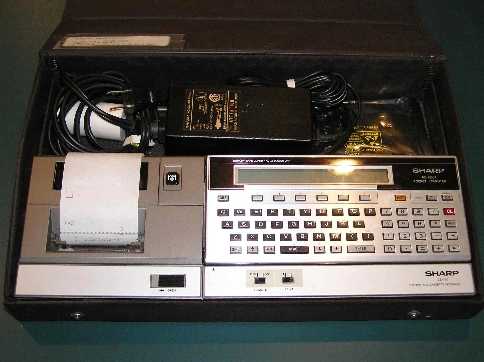|
very impressive: its display was only two characters longer then its
predecessor's, but at least it featured "one line graphics", i.e. it was a "gap-less"
display with 7 x 156 pixels.
With 3.5 KB memory, the PC-1500 had not much more RAM available for BASIC (1850 bytes) than the PC-1211 (1424 steps).
Moreover, it was quite bulky (25 mm thick, 375 g), though it might have been an advantage, as these batteries are
cheap and easily replaceable.
Presumably, the most important advantage was the expandability of the system. Several RAM extensions (some even with
battery back-up), program modules, a "docking station" with cassette interface and color plotter with full
graphics capabilities accessible with BASIC, an external board with programmable function buttons, various interfaces
etc. were available. Moreover, the PC-1500 was also programmable in machine code. Apart from that, nothing comparable
was available from other manufacturers at that time. Later strongest competitor Casio had their
FX-702P, and they were only about to release their PB-100, which had rather weak specifications.
The PC-1500 was released in late 1981 in Japan and early 1982 in the rest of the world. It was built around the LH
5801 8-bit CMOS processor, which ran at 1.3 MHz. The RAM consisted of three parts. The 1KB system RAM was made up
by two TC5514 1k x 4bit chips, a legacy from the PC-121x series. This area was used for system memory and part of the
fixed variables. User RAM was realized with a HM6116 2k x 8 bit chip, most of it available for BASIC (1850 Bytes).
Additional 512 Bytes incorporated in the display driver chips were used for the rest of the fixed variables and
the display buffer.
The RAM could be expanded by RAM modules in different sizes, the largest of which was 16KB (actually, there was also a
32KB module, which had two switchable 16KB pages, i.e. only 16KB could be used at a time). There was also a widely known
method to build a self-made RAM expansion up to 32KB.
As with the PC-1211, there was a custom manufactured version of the PC-1500 built by Sharp for Tandy Radio Shack, called the TRS-80 PC-2. Apart from a different keyboard layout, it was identical.
Two years later, the slightly expanded model PC-1500A was released (in Japan and maybe some other countries labeled
as PC-1501). It was equipped with four HM6116 RAM chips, which made 5946 Bytes available for BASIC and an additional 1KB
area for machine code only.
|




